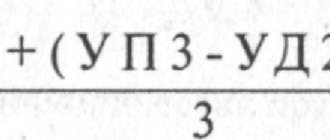Hello, dear readers! Only a harmonious personality can be successful and happy at the same time, do you agree? And an important aspect of such a personality is normal self-esteem. Not inflated to the skies, when a person imagines himself to be a genius without reason. And not low, from which it is impossible to move forward.
Problems with self-esteem are often an unstable psyche, anxiety, disappointed expectations or inadequate goals. And many unnecessary difficulties in life!
Do you want to develop harmoniously as a person, set adequate goals for yourself and achieve them?
Then you just need to determine the level of your self-esteem. You can do this right now using the Dembo Rubinstein self-esteem test. This is exactly what we offer you in this article. Important advantages of the method are the possibility of independent research, detailed explanations, and detailed instructions for the test.
A few words about the creators of the test
In fact, this Dembo-Rubinstein test is a psychodiagnostic method. It is used for a detailed study of a person’s self-esteem and self-perception. The developer of this technique was Tamara Vulfovna Dembo, a well-known psychologist in the USA, doctor of Clark University and student of Kurt Lewin. T.V. Dembo created this test in 1962.
8 years later, in 1970, it was modified by Susanna Yakovlevna Rubinstein, a famous Soviet psychologist, employee of the pathopsychology laboratory of the Moscow Research Institute of Psychiatry. Interpretation options have been added to the test.
The Dembo-Rubinstein method has been actively used by psychologists and psychotherapists for more than 40 years. With its help, you can diagnose the stability of your attitude towards yourself, the background of your mood, adequacy, maturity, the presence of problems, the level of criticality and demandingness. And also, in general, the level of satisfaction with one’s personality.
Rules for testing for preschoolers
To overcome a state of anxiety by a child, a diagnosis is made
It is important to look at the prevailing emotion. The method is also applicable for children who cannot draw
An adult offers to draw two houses: black and red. Fears are transferred from the inner “I” to the drawing. Emotions that the child is not sure about are placed in the red house. And black is filled with acutely tangible experiences. You can clarify the name of the fear. At the conversation stage, questions are listed. Does the child answer whether he is afraid or not?
The technique of open clarification also helps when it is impossible to answer yes or no. By maintaining the correct posture in relation to the person being interviewed, a trusting contact is created. Praise and approval are the key to honest answers. The amount of emotions moved into the black house is counted.
Next, the house is locked and the key (drawing) is thrown away. After which the symptoms go away, calmness sets in. According to age standards, the number of fears should not exceed ten. City residents are singled out. The usual norm was exceeded by five points. Based on several positive answers, the dominant is determined. And if the permissible limit is exceeded, they speak of a pre-neurotic state. Then they already carry out mental correction
You should not miss an important moment by postponing until later
An example of a quantitative relationship, the practical implementation of fears:
- Age 3 years: boys: 9, girls: 7
- Age 4: Boys: 7, D: 9
- Age 5 years: boys: 8, D: 11
- Age 6 years: boys: 9, girls: 11
- Age 7 years (preschoolers): boys: 9, girls: 12
- Age 7 years (schoolchildren): boys: 6, girls: 9
Calculation formula. IS = number of fears * 100%.
Age-related characteristics of the manifestation of fears. If your baby is 8 months old, it is natural for him to be afraid of strangers. And growing up, at 1.5 years old, the baby experiences prolonged absence of his mother. He is also frightened by noise in the family, doctors’ manipulations and injections. During the period of two years, if there has been experience of punishment, the child is pinched from the comments of legal representatives.
It is important to find an approach to each child. Seeing a mother yell at her baby raises questions about maturity.
After all, education in the field of education does not hinder anyone.
Moreover, many problems are being solved.
Transport
Some have observed early preschoolers panicking over modes of transportation. Kids are not used to loud noises. In this case, it is worth reassuring the child and comforting him. And regular trips will accustom you to new experiences.
Folk wisdom. Various characters live in your favorite fairy tales. Some of them are negative. When reading literary works, it is necessary to carry out an analysis, only then convey the content to children. Many fairy tales talk about deceit and cruelty.
“I myself!”
Leaving a child alone in a room creates an opportunity to develop a phobia of enclosed spaces. It would be more correct and safer to gradually get used to it, to be alone with yourself. For example, by keeping your child busy with an interesting game, you can prepare lunch. But the child must be within sight.
Fifth Corner.
At a younger age, children may experience a feeling of guilt. The root is in the unconscious behavior of the teacher, the loved one. Psychologists recommend not sending your baby to kindergarten until the age of three. Once the first socialization has occurred, it is time to expand the scope to preschool.
Life story
My cousin is an engineer by profession. But at heart he is a real psychologist! She loves all kinds of psychological tests. He enjoys testing himself and all his family and friends. She had been looking for a long time for a suitable test that would help determine the level of assessment of herself and her personality.
The various tests seemed too complicated and confusing to her. But my sister was completely satisfied with the Dembo Rubinstein test! With its help, she successfully tested not only her family, but also her colleagues.
Many of them, including managers, began to think seriously after receiving the results. I am confident that this analysis helped them embark on the path of personal development and self-improvement.
Additional techniques for the Dembo-Rubinstein technique
An additional technique includes analyzing people's behavior during testing.
Signs of unstable self-esteem:
- many crossings out (changing a line to a lower one and vice versa);
- Job execution is too slow.
Signs indicating an inflated opinion of yourself:
- the desire to attract the attention of others while performing a task;
- completing it too quickly (a person is afraid to think and truly evaluate his level, admit failure in some areas).
Another additional way is an individual conversation after testing. The person is asked to explain which people he considers happy and to name the reasons for his own failures. All other scales are discussed in the same way.
How to complete this study yourself?
Everything is quite simple. To take the Dembo Rubinstein self-esteem test, take a piece of paper (or a form) and draw four lines vertically. The height of each is clearly 100 mm. Lightly mark the middle of each scale. One point is 1 mm. A checkered sheet is ideal for this.
They will indicate indicators of health, intelligence development (smart), happiness and character. You can also add optimism and general satisfaction with yourself. for teenagers : health, character, intelligence, abilities, beauty, authority among peers, self-confidence (see picture from the Dembo Rubinstein test).
The top of the line is the state of the maximum limit of the indicator (for example, happy, smart, beautiful), the bottom is the minimum value (unhappy, stupid, ugly). . Think and put dashes on the lines where your current state is.
Dembo Rubinstein self-assessment test, student form:
Now, after reflection, draw circles (“o”) where you would like (dream) to be. And finally, the crosses are where you can still be objective if you put in the effort.
If you take a ruler, measure the distances in mm. and write them down. You have received a table where the level of your aspirations is a segment from the very bottom of the scale (zero value) to the crosses. The level of self-esteem is the interval from the bottom of the scale to the dash (-). The discrepancy is the line between the level of your aspirations (cross) and your assessment of yourself (dash).
conclusions
Using the "Ladder" it is possible
- determine self-esteem and level of life adaptation of children;
- prevent the occurrence of problems, correct deviations of self-esteem from the norm;
- teach students to interact with each other while completing a common task;
- create teams where children independently choose a role and test each other;
- teach children to positively evaluate the results of their activities.
Self-esteem is an important indicator of personality. Children of primary school age form an idea of themselves and determine their place among others. Using self-esteem diagnostic methods, an adult can promptly detect problems in a child’s sense of self. The research results help correct the student’s behavior, teach them to adequately assess their own capabilities, discover new abilities, and develop the process of self-knowledge.
Results and recommendations
Processing the results here will not take much time. The results of the test, based on the level of self-esteem, can be analyzed separately for each specific scale. Or as the arithmetic average of all indicators.
For example, if four scales were used for the study, then the total amount of points should be divided by four, if there are six scales, then the total amount should be divided by six, etc.
The health scale, as a rule, is not assessed; it is a testing scale.
Using it, the psychologist determines how correctly the test subject understood the principle of the test. But when checking myself, I found it necessary to analyze the health scale.
Keys for self-esteem level (dash)
- an increased level of assessment of a specific personality ranging from 50 points to 75, this indicator is realistic and adequate;
- your scores - from 75 to 100 - this is an overestimated indicator, it indicates moderate, but deviations in personality, slightly inflated claims, insensitivity to your mistakes;
- points up to 50 - very low self-esteem, along with it - problems with self-perception, confidence, perhaps you need specialist help and correction.
Keys to claims (crosses):
- final scores from 60 to 90 – aspirations at a realistic, achievable level;
- points from 90 to 100 – lack of criticality, inflated expectations and claims;
- points up to 60 – too low aspirations, possibly problems with personality development and self-confidence.
Types of self-esteem
In psychology, depending on how correctly a person evaluates himself, two main types of self-esteem can be distinguished: adequate, inadequate .
A person’s opinion about himself is considered adequate if it coincides with reality. Otherwise, when self-esteem sharply differs from the opinions of others, it is inadequate. In this case, self-esteem can be overestimated or underestimated.
With an underestimated assessment, self-doubt develops, which manifests itself in all human activities.
The opposite is inflated self-esteem. In this case, a person considers himself ideal or close to it.
Another criterion is stability of self-esteem . It can be stable or influenced by external factors (floating). In the first case, a person’s opinion about himself remains unchanged in any situation. With a floating assessment of oneself, it changes depending on successes and defeats, on the opinions of others, namely on approval or condemnation.
Description of the methodology for identifying children's fears
In general, fear is a completely normal process. With age, old feelings go away, and new ones may appear. Under favorable developmental conditions, children's phobias disappear. But if the process is delayed, accumulation occurs. Accordingly, personal development is inhibited. Problems with adaptation are created.
A. I. Zakharov’s work “Psychotherapy of neuroses in children and adolescents” speaks about the connection between age and fears
The technique is easy to use, but pay attention. For example, a child may say that he is not afraid of anything
Or, on the contrary, agree with all questions. But physiology speaks of something else, which is reality. Testing is carried out on an individual basis. The atmosphere is calm, the polling speed is slow.
When does it start to form?
Self-esteem cannot be formed without the presence of another personal property - self-awareness. It occurs in childhood, up to approximately 3 years of age, when the child realizes his autonomy from his mother, identifies himself with a certain gender and begins to express himself as an individual (the so-called “seven-star crisis” of this age). As a child grows up, he has the opportunity to evaluate himself at an elementary level and analyze the attitude of others towards him. At this age, we can talk about the beginnings of self-esteem, since it is formed over a long period of time and remains dynamic throughout life.
Preview:
Hopelessness scale
(HopelessnessScale, Becketal. 1974)
Below are 20 statements about your future. Please read each one carefully and mark the one correct statement that most accurately reflects your feelings at this time. Circle the word TRUE if you agree with the statement or the word FALSE if you disagree. None of the statements are right or wrong. Please circle TRUE or FALSE for all statements. Don't spend too much time on one statement.
FULL NAME_________________________________________________________________
Class________________________________________________________________
Date of Birth________________________________________________________
| 01 | RIGHT | WRONG | I look forward to the future with hope and enthusiasm |
| 02 | RIGHT | WRONG | It's time for me to give up, because... I can't change anything for the better |
| 03 | RIGHT | WRONG | When things go wrong, it helps me to think that things can't go on like this forever. |
| 04 | RIGHT | WRONG | I can't imagine what my life will be like in 10 years |
| 05 | RIGHT | WRONG | I have enough time to complete the things I most want to do. |
| 06 | RIGHT | WRONG | In the future, I hope to be successful in what I enjoy most. |
| 07 | RIGHT | WRONG | The future seems dark to me |
| 08 | RIGHT | WRONG | I hope to get more good things in life than the average person |
| 09 | RIGHT | WRONG | I have no bright spots and no reason to believe there will be any in the future. |
| 10 | RIGHT | WRONG | My past experiences have prepared me well for the future. |
| 11 | RIGHT | WRONG | All I see ahead is more trouble than joy |
| 12 | RIGHT | WRONG | I don't expect to achieve what I really want |
| 13 | RIGHT | WRONG | When I look into the future, I hope to be happier than I am now |
| 14 | RIGHT | WRONG | Things aren't going the way I want them to. |
| 15 | RIGHT | WRONG | I strongly believe in my future |
| 16 | RIGHT | WRONG | I never achieve what I want, so it's stupid to want anything |
| 17 | RIGHT | WRONG | It is highly unlikely that I will get real satisfaction in the future |
| 18 | RIGHT | WRONG | The future seems blurry and uncertain to me |
| 19 | RIGHT | WRONG | The future holds more good days than bad. |
| 20 | RIGHT | WRONG | It's no use trying to get what I want because I probably won't get it. |
| № | Answer | Point | № | Answer | Point |
| 01 | WRONG | 1 | 11 | RIGHT | 1 |
| 02 | RIGHT | 1 | 12 | RIGHT | 1 |
| 03 | WRONG | 1 | 13 | WRONG | 1 |
| 04 | RIGHT | 1 | 14 | RIGHT | 1 |
| 05 | WRONG | 1 | 15 | WRONG | 1 |
| 06 | WRONG | 1 | 16 | RIGHT | 1 |
| 07 | RIGHT | 1 | 17 | RIGHT | 1 |
| 08 | WRONG | 1 | 18 | RIGHT | 1 |
| 09 | RIGHT | 1 | 19 | WRONG | 1 |
| 110 | WRONG | 1 | 20 | RIGHT | 1 |
Interpretation
Maximum score – 20 points
0-3 points – hopelessness is not identified;
4-8 points – mild hopelessness;
9-14 points – moderate hopelessness;
15-20 points – severe hopelessness.










